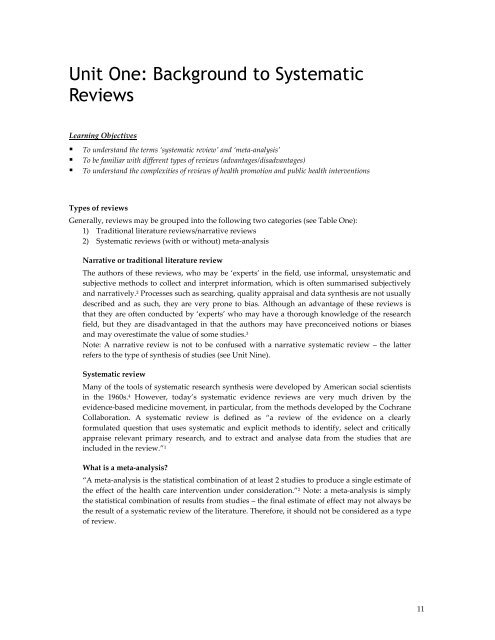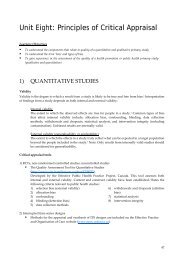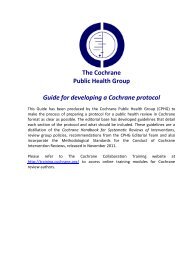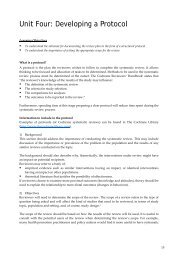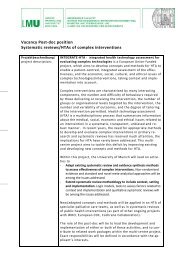Train the Trainer Course book - Cochrane Public Health Group
Train the Trainer Course book - Cochrane Public Health Group
Train the Trainer Course book - Cochrane Public Health Group
Create successful ePaper yourself
Turn your PDF publications into a flip-book with our unique Google optimized e-Paper software.
Unit One: Background to Systematic<br />
Reviews<br />
Learning Objectives<br />
To understand <strong>the</strong> terms ‘systematic review’ and ‘meta-analysis’<br />
To be familiar with different types of reviews (advantages/disadvantages)<br />
To understand <strong>the</strong> complexities of reviews of health promotion and public health interventions<br />
Types of reviews<br />
Generally, reviews may be grouped into <strong>the</strong> following two categories (see Table One):<br />
1) Traditional literature reviews/narrative reviews<br />
2) Systematic reviews (with or without) meta-analysis<br />
Narrative or traditional literature review<br />
The authors of <strong>the</strong>se reviews, who may be ‘experts’ in <strong>the</strong> field, use informal, unsystematic and<br />
subjective methods to collect and interpret information, which is often summarised subjectively<br />
and narratively. 2 Processes such as searching, quality appraisal and data syn<strong>the</strong>sis are not usually<br />
described and as such, <strong>the</strong>y are very prone to bias. Although an advantage of <strong>the</strong>se reviews is<br />
that <strong>the</strong>y are often conducted by ‘experts’ who may have a thorough knowledge of <strong>the</strong> research<br />
field, but <strong>the</strong>y are disadvantaged in that <strong>the</strong> authors may have preconceived notions or biases<br />
and may overestimate <strong>the</strong> value of some studies. 3<br />
Note: A narrative review is not to be confused with a narrative systematic review – <strong>the</strong> latter<br />
refers to <strong>the</strong> type of syn<strong>the</strong>sis of studies (see Unit Nine).<br />
Systematic review<br />
Many of <strong>the</strong> tools of systematic research syn<strong>the</strong>sis were developed by American social scientists<br />
in <strong>the</strong> 1960s. 4 However, today’s systematic evidence reviews are very much driven by <strong>the</strong><br />
evidence-based medicine movement, in particular, from <strong>the</strong> methods developed by <strong>the</strong> <strong>Cochrane</strong><br />
Collaboration. A systematic review is defined as “a review of <strong>the</strong> evidence on a clearly<br />
formulated question that uses systematic and explicit methods to identify, select and critically<br />
appraise relevant primary research, and to extract and analyse data from <strong>the</strong> studies that are<br />
included in <strong>the</strong> review.” 1<br />
What is a meta-analysis?<br />
“A meta-analysis is <strong>the</strong> statistical combination of at least 2 studies to produce a single estimate of<br />
<strong>the</strong> effect of <strong>the</strong> health care intervention under consideration.” 2 Note: a meta-analysis is simply<br />
<strong>the</strong> statistical combination of results from studies – <strong>the</strong> final estimate of effect may not always be<br />
<strong>the</strong> result of a systematic review of <strong>the</strong> literature. Therefore, it should not be considered as a type<br />
of review.<br />
11


